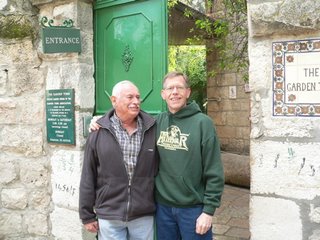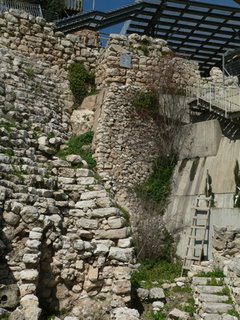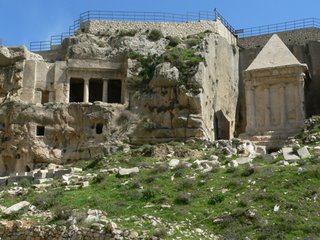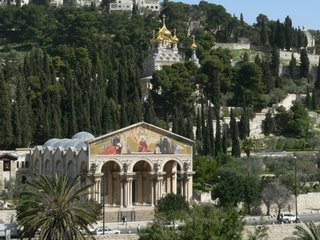




My second weekend in Jerusalem is over and I’m back at work (it’s already Wednesday). I have an interesting update from my weekend to share with you though, plus some great photos.
I woke up early on Saturday morning, glad that it was sunny and warm again after the chilly, rainy days we’d had since last Wednesday. In fact, we got hit with an African dust storm on Thursday that was miserable! I had a 9:00 a.m. appointment, once again at the Garden Tomb--but this time to meet my friend, Gabi Herz, who has been our tour guide on all three of the Holy Land trips I’ve taken. He had a group from Canada who was scheduled to begin their touring day with communion at the Tomb, so we met there. We had a wonderful time catching up on our lives, and drinking good strong Turkish coffe as we chatted. Many of you know Gabi too. He looks great--at 70--and is as active and humorous as ever.
When I left Gabi, I had to get a new battery for my watch. I went into the Arab Quarter, because the Jewish Quarter was shut down for shabbat, and I found a jeweler (on the Via Dolorosa) who replaced the battery for 15 shekels. I also stopped at a spice vendor and bought fresh ground cardamom, so I can make Swedish cardamom bread for devotions this week. It only cost me 2 shekels! I really like walking around this part of the Old City. The Arabs are so “in your face” but very pleasant, and seem to like it when I say I’m from California in the USA. It was as crowded as ever, and I pushed and jostled my way through the narrow lanes that make up this part of the Old City, relishing the colorful sights, the delicious smells, and the noisy sounds of the vendors hawking their wares as I headed to the Mount of Olives.
However, on my way there I noticed a sign to the “City of David.” From my reading of archeology, I know that this is an important place, and I’ve seen many pictures of the “digs” that have been going on here for many years. I made a detour and even though the site was officially closed for shabbat, the guard said I could go in and look around if I wanted to. I did--and I was thrilled to see that this is the very site I was going to spend a lot of time looking for later in my sabbatical! The tourism board has made this site very “tourist friendly,” with good signs, organized pathways, refreshment and souvenir center, and best of all, has connected all the amazing places from the Bible that are in this location: the Gihon Spring, Pool of Siloam, Hezekiah’s Tunnel, ruins from the time of David, and Warren’s Shaft, which many believe is the way that David and his men conquered Jerusalem (see II Samuel 5:8). I was really excited, and slowly made my way down the hill, taking pictures of the ruins, seeing the entrances to the waterways, and awed by the view of the Old City walls from the deep valley of Silwan, the Palestinian village directly south of the wall. At the bottom, I started up the road that leads to the Kidron Valley (between the Old City and the Mount of Olives), eager to see the old tombs that I knew I would pass on the way.
Before I got very far though, a young Palestinian man stopped me and asked if I would like a tour of the City of David. His name was Samuel, and he claimed he has been involved in the work on these sites and could take me in to them. I was suspicious, and said I had no time today. However, he did show me the Gihon Spring and new entrance to Hezekiah’s Tunnel, which looks better than when I walked through it in ‘92. I took Samuel’s phone number so I can contact him in the future if I want to use his services.
Then I headed for the tombs: Zechariah’s, Bnai Hezir, and Absalom’s Pillar. I walked all around them, taking photos and relishing this opportunity to take lots of time to get “up close and personal” with these well-known sites outside the city walls. This is also where the Hinnom and Kidron Valleys meet--and I was standing right in the midst of them! It was a thrill to walk in the Kidron toward the Mount of Olives, just as Jesus must’ve walked here on his way from the Last Supper in Jerusalem to the Garden of Gethsemane (see John 18:1). I stopped at Gethsemane, which is one of my favorite holy sites because it is so quiet, beautiful, and authentic. I photographed the ancient olive trees (some are the offshoots of the trees that were present at the time of Christ) and went into the Church of All Nations which is built over the rock where, supposedly, Jesus prayed in the garden. I read the gospel accounts from Luke and John, and pondered all that happened to Jesus here. However, the church closed at noon before I take photos inside, so I realized I would have to return on Sunday. This would also be a better time to do the entire Mount of Olives experience because I was exhausted from everything I’d already done today! I walked home back through the Old City, amazed at how familiar much of it was to me already, and spent the rest of shabbat quiet and alone.
On Sunday morning I returned to the Mount of Olives. It took less than half an hour to get there, but before I arrived at the garden entrance I stopped at the Tomb of Mary, across the street. I don’t know how there can be such a place; Catholics claim she was assumed into heaven before she died! A long set of stone steps led deep underground, and it was clearly an old Orthodox site. I prayed in one of the little chapels there, enjoying the pungent smell of incense that permeates every Orthodox holy site. Outside again, I noticed another walkway to an entryway with the word “Gethsemane” overhead. I walked in, and found a beautiful small chapel here, supposedly part of the original garden that included an olive press (the meaning of the word, Gethsemane).
Finally, I returned to the garden and church. However, this time it was so full of tourists that I couldn’t even get up to the rock! Instead, a pleasant Arab man let me into the private olive garden of the Catholic friars who take care of Gethsemane, where I enjoyed the quiet and the views of the Old City.
After my rest, it was time to begin the very steep uphill “Palm Sunday Walk” to the top of the Mount of Olives. Fortunately, the way is paved today! Not the rocky road it must’ve been when Jesus rode down it on the donkey. On the way, I passed an old Arab with a donkey. He was very sociable, and wondered if I’d like to take a picture of him and his animal. I did--and of course it cost me 5 shekels!
Half way up the walk is the beautiful “Dominus Flevit,” the “Church of the Tear.” Here is where Jesus wept over the city on his way into Jerusalem (Luke 19:41-44), and the chapel provides one of the most unique views of the Old City. However, a tour group was having a private mass inside, so I couldn’t get in here either. I did have another tourist take a picture of me with the Old City in the background (see photo above).
Huffing just a bit, I finally got to the top of the Mount of Olives. There, stretched out from south to north, is the most stunning view of Jerusalem that you’ll ever find: the south and east walls of the Old City, the steps that led to the temple at the time of Christ, the Kidron Valley, Mount Zion, the City of David (where I’d hiked just one day earlier), the Church of St. Peter in Galicantu (built over Caiaphas’ home, where Peter denied Jesus three times), the Lion’s Gate, the Golden Gate, and towering above it all, the Dome of the Rock. I sat down and soaked up the sight, deeply moved by it, and by the fact that I am able to walk and shop and pray and visit all the sites here in this incredible Holy City whenever I want to. What a blessing this sabbatical is already!
I munched an apple and had a drink of water, then headed back down the Palm Sunday Walk to Dominus Flevit. Now no one was there at all! I had the whole chapel to myself. I carefully framed the window behind the altar that looks directly across to the Temple Mount, so that the cross of Christ pierced the golden top of the Dome of the Rock of Mohammed, and snapped a fantastic picture (see it above). This quiet setting is perfect for reflection, and if there had been some people there to sing, the acoustics are marvelous too.
Continuing down the hill, I stopped for some coffee at a little cafe by Gethsemane. It is run by a Muslim, and he was quite talkative! He had much to say about America (he loves the USA), George Bush (“he’s a murderer”), terrorists (they are evil, and distort Islam’s message of peace and light), and religion (though we have different beliefs, we all pray in our sanctuaries to Almighty God). He had plenty of time to fill me in on his perspectives too, because it took him half an hour to make my Turkish coffee with cardamom!
Over an hour remained until Gethsemane re-opened, so I started walking back across the Kidron Valley and around the Old City to see St. Peter in Galicantu. On the way, it was fun to look down on the old tombs that I had visited the previous day. I pushed up the hill to get to the church--and found it is closed on Sundays! Since I was close to the Zion Gate (where you can see the bullet holes from the 1948 war), I went to look at it, and then continued to where David’s Tomb and the Upper Room are located on Mount Zion. I visited the Dormition Abbey instead, because I’ve never visited it, and the church is a landmark on the Jerusalem skyline. Mary is supposed to have lived here after the resurrection of Jesus. It’s an interesting and beautiful church, and so is the crypt below.
It was just 10 minutes until Gethsemane re-opened and I had that long return walk ahead of me--downhill, fortunately! I took off at a fast pace, went into the church, and found only a few nuns praying at the railing in front of the rock. I joined them, spent some minutes in prayer and reflection, then used the railing to balance my camera and to get some excellent pictures of the interior. It was a great ending to my day on the Mount of Olives.
I also went to church Sunday evening with some of my friends from BFP, to King of Kings Community Church. It is made up of a lot of internationals who live in Jerusalem, and it was a powerful night of worship! The congregation is very free, alive, active! The opening worship and singing lasted nearly an hour, with praise choruses that we do in Hilmar, plus a number of Messianic Jewish songs, call/response numbers, songs with dance movements (which the entire congregation seemed to know--and everyone joined in!), prayer and Scripture time, and moments of reflection. This night, a black gospel choir from San Antonio was visiting, and joined the church’s worship team, making the music all the more enlivening. The pastor from Texax spoke on “worship that heals,” and it was both inspiring and challenging. When the service ended, it was 7:15 p.m.--and I was shocked that we’d been worshiping for nearly two and a half hours! I’m definitely returning to this church in the coming weeks!
This is enough for now. I’m sure you agree! But I hope you’re catching a bit of the excitement and fun I’m having, living here in Jerusalem and taking good advantage of all the opportunities I have to experience so many new things.
Toda, and shalom (Thanks, and peace) in the name of Y’shua.
Dan
Photos: 1. Gabi and me 2. south tower of Jerusalem from time of David 3. tombs in the Kidron Valley 4. olive trees in the Kidron, looking across to the Old City wall and the Golden Gate 5. Mt. of Olives--Church of All Nations in foreground. 6. olive trees in Garden of Gethsemane 7. rock inside the Church of All Nations, where Jesus prayed 8. Dominus Flevit (“Church of the Tear”) where Jesus cried over Jerusalem 9. window behind the altar of Dominus Flevit--cross piercing Dome of the Rock! 10. another view of cross and Dome. 11. me on the wall outside of Dominus Flevit; Dome of the Rock and Golden Gate in background 12. Orthodox Jewish funeral at the graves on the Mt. of Olives--Old City in background 13. a group observing the Stations of the Cross on the Via Dolorosa


0 Comments:
Post a Comment
<< Home